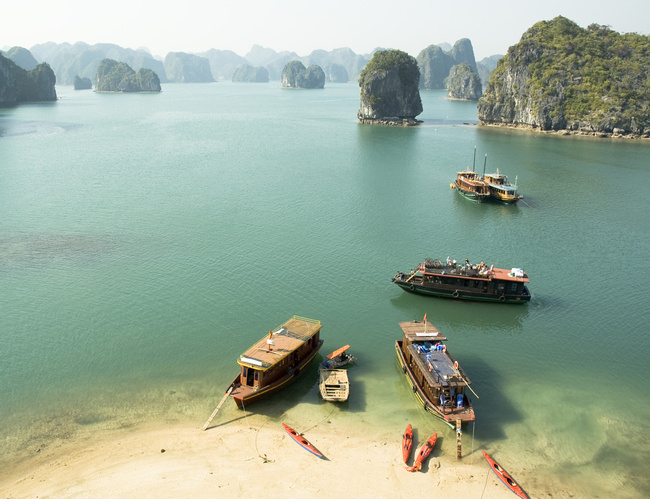- Travel Guides
Art and Music
Art history in Vietnam reflects the shifting imperial powers of China, Japan, and France. Before the 20th century, much of Vietnam’s art could be found in the intricate artwork of the Buddhist temples. Temples and pagodas are still the greatest repositories of the country’s art history. Secular Vietnamese art comes in the form of handicrafts — lanterns, embroidery, and brightly colored propaganda posters make up the swirl of color that visitors remember from their trip to Vietnam.

During the 1930s, Vietnam started to produce work influenced by the west, particularly the work by students of the Fine Arts College of Indochina. This school taught a European perspective and employed French professors. Collectors favor this type of Vietnamese art, and because it has enjoyed increasing popularity, the number of fakes has also increased.
Vietnam’s popular culture has embraced Hollywood, and they have a particular fondness for the Fast and Furious franchise. You can see their love of daredevil driving in their daily commutes. But tradition persists, and the economy’s reliance on tourism has ensured that Vietnam will maintain their traditional crafts for generations to come.
Native Handicrafts
At certain rest stops guides will inform you that the proceeds from sales is going toward a good cause. The Vietnamese government has made a concerted effort to hire handicapped artists to make the souvenirs that line the shelves. In souvenir shops all over the country you’ll see an image of three women in rice hats painted with broad brushstrokes. In addition to the mass-produced art, Many towns have specialty crafts. Below are some of the most popular spots to pick up native crafts.
Mekong Delta
As you make your way through the Mekong Delta, you’ll stop in villages where women weave baskets and other household items from strong reeds. Weavers are happy to demonstrate their techniques, and are even happier for you to purchase their crafts.
Sa Pa
H’mong women are known for their needlepoint. Today, many H'mong sustain themselves by selling their handicrafts. Since it’s an important source of income, some vendors also sell mass-produced items. If you want to buy something original, make sure to buy your souvenirs directly from a workshop.
Keep in mind — once you buy something from one stall, the nearby women will even more strongly encourage you to buy from then. Give a firm, consistent “no” if you’re not interested.
Hoi An
As you walk the streets of Hoi An, you’ll see paper lanterns strung across the streets. In addition to bright colors, they’re also often painted with charming patterns. At night, their soft lights make the streets look especially magical.
In addition to lanterns, Hoi An is also known for its seamstresses. Merchants may approach you offering to turn a garment around within 24 hours. It’s possible to have something done this quickly, but those garments are likely to be of inferior quality. Give yourself some time to get alterations. Customers can buy exceptionally affordable suits, or get some loose-fitting, lightweight pants that are ideal for visiting temples in the sweltering heat.
Water Puppets
Tu Dao Hanh invented water puppetry in the 11th century. To this day, visitors can see water puppet performances, which are especially popular in Hanoi. Puppet masters remain beneath the surface of the water for the entirety of the performance. (How, you ask? It’s supposed to be a mystery, so we won’t ruin the fun.) For the best water puppetry Vietnam has to offer, head to the Thang Long Water Pupper Theater in Hanoi, which is located just northeast of Hoan Kiem Lake.
Propaganda as Art
Artists contributed a colorful, free-spirited style to propaganda posters plastered on sides of buildings during the Vietnam War. They come with slogans like ''Forever Remember the Contribution of Uncle Ho!'' (Uncle Ho is Vietnam’s nickname for Ho Chi Minh, the founder of Vietnam’s Communist party.)
You can buy reproductions of propaganda posters all over the country. Check out the offerings in the gift shop in the basement of the War Remnants Museum for some choice examples.
Music
K-pop is popular among young Vietnamese people, and Vietnamese tune in to watch Korean singing competitions online. Karaoke is a popular pastime. Traditional folk is considered the . In rural areas, it’s common to see people playing instruments they made themselves.
Styles vary from region to region. For instance, in the north you might find a village where they practice xoan singing, which began as a form of worship for an ancient king. Hò music comes from southern Vietnam, and it is performed as a flirtatious conversation between young men and women. In the Mekong Delta you can hear lots of sad folk songs about beautiful Mekong girls who leave their rural life behind to marry wealthy businessmen.
It's more than just having a good time or visiting beautiful places (although that's absolutely a part of it!), it's about being part of a unique experience that stays with you.



